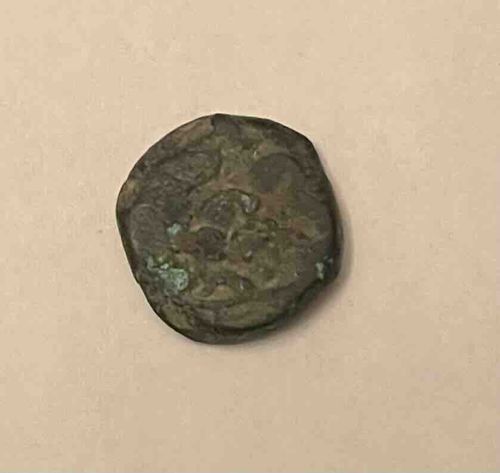
Ancient or Medieval Bronze Coin
The item appears to be an ancient or medieval coin, characterized by its irregular, somewhat flattened, spherical shape, which suggests it was likely hand-struck. The material seems to be bronze or copper alloy, indicated by the dark green to brown patina that covers its entire surface. There are noticeable areas of lighter green corrosion, particularly on the lower left quadrant, which suggests copper oxidation (verdigris). This level of patination is typical of metallic artifacts exposed to environmental elements over a prolonged period. The coin's surface is heavily worn, obscuring most of the original design. However, some raised features are still discernible in the center, possibly depicting a bust or a symbolic figure, though specific details are entirely lost due to wear and corrosion. No discernible text, dates, or clear identifying marks are visible, making precise identification challenging without further examination or cleaning. The edges are irregular and uneven, reinforcing the impression of ancient manufacturing techniques rather than modern minting. The overall condition suggests significant circulation or burial, leading to the loss of fine details and some surface pitting. Despite the heavy wear, the coin retains its overall form, indicating a robust metal composition. Its small to medium size is typical for coinage of various historical periods, but without a scale reference, an exact measurement cannot be provided. The craftsmanship, though difficult to assess due to its condition, was likely rudimentary compared to later precision minting.
AI-Generated Appraisal Disclaimer
Estimated Value
$5-15
Basic Information
Category
Coin
Appraised On
November 30, 2025
Estimated Value
$5-15
Item Description
The item appears to be an ancient or medieval coin, characterized by its irregular, somewhat flattened, spherical shape, which suggests it was likely hand-struck. The material seems to be bronze or copper alloy, indicated by the dark green to brown patina that covers its entire surface. There are noticeable areas of lighter green corrosion, particularly on the lower left quadrant, which suggests copper oxidation (verdigris). This level of patination is typical of metallic artifacts exposed to environmental elements over a prolonged period. The coin's surface is heavily worn, obscuring most of the original design. However, some raised features are still discernible in the center, possibly depicting a bust or a symbolic figure, though specific details are entirely lost due to wear and corrosion. No discernible text, dates, or clear identifying marks are visible, making precise identification challenging without further examination or cleaning. The edges are irregular and uneven, reinforcing the impression of ancient manufacturing techniques rather than modern minting. The overall condition suggests significant circulation or burial, leading to the loss of fine details and some surface pitting. Despite the heavy wear, the coin retains its overall form, indicating a robust metal composition. Its small to medium size is typical for coinage of various historical periods, but without a scale reference, an exact measurement cannot be provided. The craftsmanship, though difficult to assess due to its condition, was likely rudimentary compared to later precision minting.
Related Tags
Get Your Items Appraised
Instant estimates of your treasures with AI-powered instant appraisals